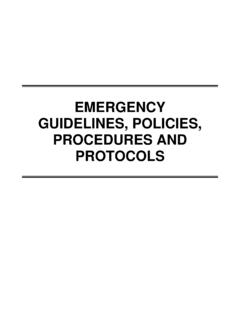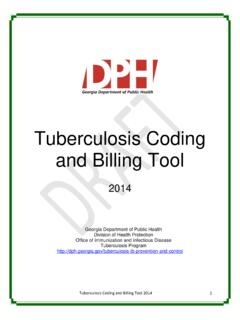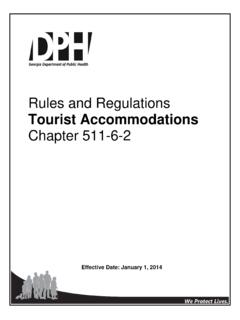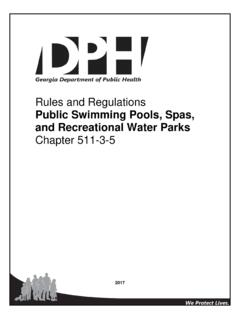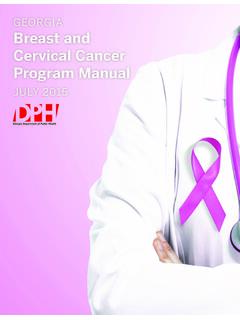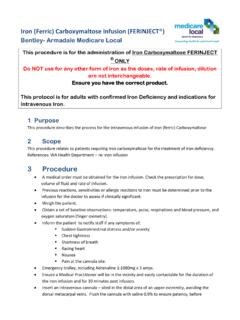Transcription of EMERGENCY GUIDELINES, POLICIES, PROCEDURES AND …
1 EMERGENCY GUIDELINES, POLICIES, PROCEDURES AND PROTOCOLS THIS PAGE INTENTIONALLY LEFT BLANK Department of Public Health Nurse Protocols for Registered Professional Nurses 2014 2013-2014 EMERGENCY CLINICAL REVIEW TEAM Meshell McCloud, RN, MS, APRN, WHNP- BC Deputy Chief Nurse, Office of Nursing Department of Public Health Patrick O Neal, MD Medical Consultant Office of EMERGENCY Preparedness and Response Lawton C. Davis, MD South Central Health District (Dublin) District 5 Unit 1 District Health Director Gina Richardson, RN Debbie York, RN, MSN, APRN Clinical Nurse Supervisor Medical Access Clinic District 1 -2 Whitefield County Health Department County Nurse Manager Burke County Health Department Michelle Fields, RN, MPH Nursing Supervisor College Park Penny Conner, BSN, RN Immunization Nurse Consultant Jill Mabley, MD, FAAEM Deputy State Medical Director Fulton County Health Department District 3-2 Donelle Franklin, RPh, MBA Assistant Pharmacy Director Office of EMERGENCY Preparedness and Response C.
2 Paige Lightsey, RNCounty Nurse Manager Georgia Department of Public Health Division of Health Protection Office of Pharmacy Alan Satterfield, BSN, RN, BS County Nurse Manager Hall County Health Department McIntosh County Health Department District Department of Public Health Nurse Protocols for Registered Professional Nurses 2014 THIS PAGE INTENTIONALLY LEFT BLANK Department of Public Health Nurse Protocols for Registered Professional Nurses 2014 TABLE OF CONTENTS EMERGENCY GUIDELINES, POLICIES, PROCEDURES and PROTOCOLS 12 Guidelines for EMERGENCY Kits/Carts Guidelines for ALTERED LEVEL OF CONSCIOUSNESS/Syncope (Fainting)/Seizure Activity PROCEDURES for Allergic Reactions, Including Acute Anaphylaxis, in Adults, Infants and Children Allergic Reaction/Anaphylaxis Record policy for Reviewing EMERGENCY Protocols/ PROCEDURES EMERGENCY Checklist Evaluation Tool for Practice Drill Shock/Hemorrhage Recognizing Allergic Reaction, Including Acute Anaphylaxis.
3 And Use of Auto-Injectable Epinephrine By Public Health Nurses Working in School Health Settings Appendix A Pediatric Vital Signs Resource Chart Department of Public Health Nurse Protocols for Registered Professional Nurses 2014 THIS PAGE INTENTIONALLY LEFT BLANK Department of Public Health Nurse Protocols for Registered Professional Nurses 2014 EMERGENCY Guidelines, Policies, PROCEDURES and Protocols GUIDELINES FOR EMERGENCY KITS/CARTS IN PUBLIC HEALTH CLINIC SITES A. GENERAL policy Local factors such as anticipated EMS response time, the availability of a physician and the ability of trained personnel to initiate an EMERGENCY procedure in the event of vasovagal syncope, and/or an acute anaphylaxis/allergic reaction will determine the need for supplies beyond the minimum and expanded protocol/procedure for some clinics.
4 EMERGENCY plans and PROCEDURES should be coordinated with the local EMERGENCY Medical System (EMS). All EMERGENCY drugs and supplies should be kept together in a secured kit or cart that is easily moveable and readily accessible/visible during clinic service hours. Inventory should be checked monthly with careful attention to medication expiration dates and the working condition of equipment. B. DEFINITION OF EMERGENCY KIT/CART EMERGENCY kits/carts are those drugs and supplies which may be required to meet the immediate therapeutic needs of patients and which are not available from other authorized sources in sufficient time to prevent risk or harm to patients. Medications may be provided for use by authorized health care personnel in EMERGENCY kits/carts, provided such kits/carts meet the following requirements: 1.
5 Storage EMERGENCY kits/carts shall be stored in limited-access areas and sealed with a disposable plastic lock to prevent unauthorized access and to insure a proper environment for preservation of the medications in them. 2. Labeling - Exterior The exterior of EMERGENCY kits/carts shall be labeled so as to clearly and unmistakably indicate that it is an EMERGENCY drug kit/cart and is for use in emergencies only. 3. Labeling Interior All medications contained in EMERGENCY kits/carts shall be labeled in accordance with the name of the medication, strength, quantity, and lot # and expiration date. Department of Public Health Nurse Protocols for Registered Professional Nurses 2014 EMERGENCY Guidelines, Policies, PROCEDURES and Protocols 4.
6 Removal of Medications Medications shall be removed from EMERGENCY kits/carts only pursuant to nurse protocol/procedure, by authorized clinic personnel or by a pharmacist. 5. Inspections Each EMERGENCY kit/cart shall be opened and its contents inspected by RN/APRN/Pharmacist/MD monthly with the exception of oxygen (every 6 months). The monthly inspection shall be documented on an EMERGENCY Check-Off Log sheet which includes: a. the listing of all EMERGENCY supplies and equipment, b. the name of the medication(s), its strength, quantity, lot # and expiration date, c. the staff member s name who performed the inspection and d. the inspection date. Upon completion of the inspection, the EMERGENCY kit/cart shall be resealed with the appropriate disposable plastic key.
7 6. Minimum Medication(s) a. Epinephrine 1:1000, 1 ml (2 ampules) b. Diphenhydramine 50 mg/mL (2 ampules) c. Diphenhydramine elixir/solution mg/5 mL (1 bottle) d. Diphenhydramine HCl 25 mg caps (1 bottle) e. Portable oxygen (by nasal cannula at 5 L/ min unless patient has history of emphysema or chronic lung disease when it should be administered at 2L/min). 7. Minimum Supplies a. Blood pressure cuffs (adult and child) b. Stethoscope c. Flashlight/extra batteries d. Copy of EMERGENCY protocols/ PROCEDURES e. Allergic Reaction/Acute Anaphylaxis Record f. Bag-valve-mask (AMBU) for resuscitation (Infant/Child/Adult ) g. Copy of initialed current Monthly Checklist of Drugs and Supplies h.
8 Nasal cannula for oxygen administration i. Needles and syringes j. Filter needles, 5 micron, for use when aspirating a medication from a glass ampule, to reduce contamination Department of Public Health Nurse Protocols for Registered Professional Nurses 2014 EMERGENCY Guidelines, Policies, PROCEDURES and Protocols 8. Recommended Additional Supplies and Medications (For use where additional protocol/ PROCEDURES and trained personnel are available) a. Pulse-oximeter b. Automated external defibrillator (AED) c. Epinephrine Auto-injector mg (3 doses) d. Epinephrine Auto-injector mg (3 doses) Department of Public Health Nurse Protocols for Registered Professional Nurses 2014 EMERGENCY Guidelines, Policies, PROCEDURES and Protocols THIS PAGE INTENTIONALLY LEFT BLANK Department of Public Health Nurse Protocols for Registered Professional Nurses 2014 EMERGENCY Guidelines, Policies, PROCEDURES and Protocols GUIDELINES FOR ALTERED LEVEL OF CONSCIOUSNESS/SYNCOPE (FAINTING)/SEIZURE ACTIVITY DEFINITION Syncope (fainting) is a transient loss of consciousness accompanied by loss of postural tone due to decreased blood supply to the brain.
9 Syncope is commonly a benign vasovagal event; however, it may represent a serious medical event, particularly in the elderly. Typical vasovagal syncope occurs in a person in upright position with appropriate stimulus ( , fear or pain from blood draw or injection). By definition, vasovagal symptoms resolve when recumbent position restores blood flow to the brain. The main goal of evaluation of patients who faint, are dizzy or have altered LOC is to identify those who are at risk for or are experiencing acute medical emergencies such as volume depletion, cardiac, metabolic or neurologic event. ETIOLOGY Vasovagal syncope is usually due to emotional stress related to fear or pain ( , having blood drawn or an injection).
10 OBJECTIVE 1. Fall in blood pressure 2. Dizziness. 3. Nausea. 4. Diminished vision. 5. Slow pulse. 6. Pallor, perspiration. 7. May progress to loss of postural tone and consciousness. 8. Seizure Activity. ASSESSMENT Loss of postural tone and consciousness, etiology to be determined PLAN 1. Protect patient from fall injury. Position the patient in the recumbent position with legs elevated. Loosen tight clothing at the neck and waist. If the patient does not immediately regain consciousness, call 911 for EMS support and consider lateral decubitus position to prevent aspiration or airway obstruction.
